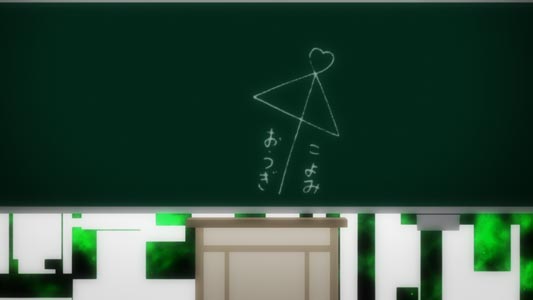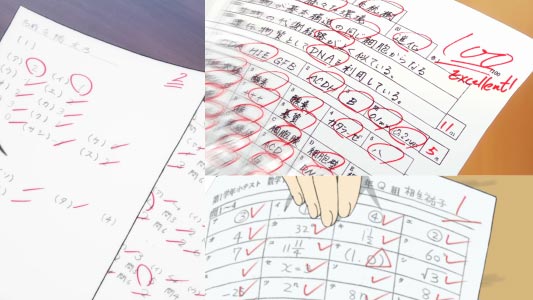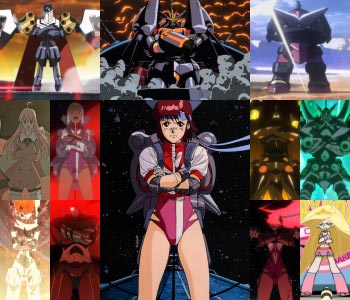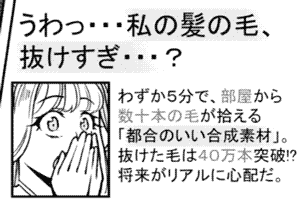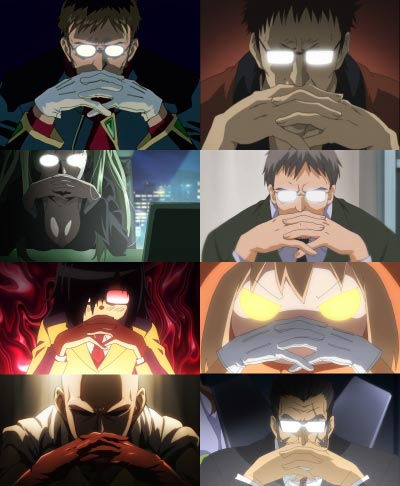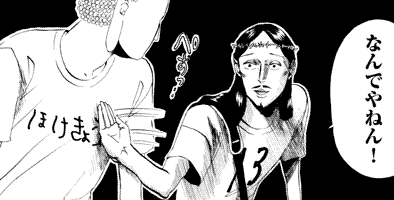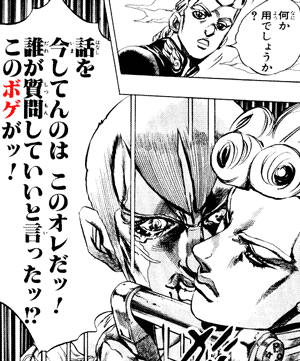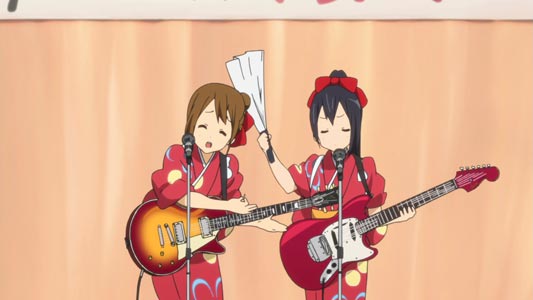In Japanese, a triangle (△), sankaku 三角, is sometimes used to mean an answer is partially correct. A right answer is a circle (○), while a wrong answer is either an X mark or, in school tests, a check mark (✓) or tick.
maru ○, ◯ (Circle Mark) - Meaning in Japanese
In Japanese, a circle (○ or ◯), maru 丸, has multiple uses: it typically means something is "correct," that an answer is "right." In this case, "wrong" is either an X mark or a check mark (✓), and a triangle (△) is half-right. It's also used as a placeholder, specially to censor words. And it may be used instead of the digit zero, 0.
This article is about the circle symbol, not about a "circle," saakuru サークル, in the sense of a group of people that do an activity like drawing doujinshi 同人誌.
Anime: Himouto! Umaru-chan 干物妹!うまるちゃん (Episode 1)
Anime: Nichijou no Zero-wa 日常の0話 (Episode 0, OVA)
batsu × (X Mark) - Meaning in Japanese
In Japanese, an "X mark" (☓), batsu-jirushi バツ印, typically means an answer is "incorrect," fuseikai 不正解, although it can also mean something is dame 駄目, "not good," NG, "not allowed," "didn't work out." The opposite symbol is a "circle" (○), maru 丸. These symbols are also used as placeholders.
Gainax Stance
In anime, Gainax pose, or Gainax stance, in Japanese: gaina-dachi ガイナ立ち, literally "Gaina-standing," refers to a way for a character, usually a giant robot, or giant robot pilot, to stand imposingly as it waits for battle: with arms crossed and legs apart, due to its prominent use by animation studio Gainax, ガイナックス.(dic.pixiv.net, tvtropes.org)
Anime: Top wo Nerae 2! Diebuster, トップをねらえ2!DieBuster (Episodes 2, 4, 6)
Anime: Tengen Toppa Gurren Lagann, 天元突破グレンラガン (Episodes 3, 15, 25)
Anime: Panty & Stocking with Garterbelt, パンティ&ストッキングwithガーターベルト (Episode 2)
Sunrise Stance
In anime, when a character stands with legs apart readying their sword (or other weapon) thrusting it forward, and the camera perspective is warped so the sword looks far bigger than normal, that's called a Sunrise Stance (サンライズ立ち), Sunrise Perspective (サンライズパース), Brave Perspective, Yuusha Perspective (勇者パース), Brave Stance, Yuusha Stance (勇者立ち), Fukuda Perspective (福田パース), or, in Chinese, 大張一刀流 (Oobari Ittouryuu?).(dic.pixiv.net:勇者パース, dic.nicovideo.jp:サンライズ立ち, tvtropes.org:SwordPointing)
Anime: Onmyou Taisenki 陰陽大戦記 (Episode 20)
Anime: Aikatsu Stars!, アイカツスターズ! (Episode 37)
Anime: Hacka Doll The Animation, ハッカドール THE・あにめーしょん (Episode 9)
うわっ・・・私の年収、低すぎ・・・?
In Japanese, uwa'... watashi no nenshuu, hiku-sugi...? うわっ・・・私の年収、低すぎ・・・?, meaning something like "yikes... my salary, it's too low...?" is a text used in an internet ad by a job-search company called @type, which featured a woman covering her mouth in shock, presumably after realizing how little she made. The ad copy became a meme, with parodies found even in manga and anime.
Gendo Pose
In anime, placing your elbows on a desk and interlacing your fingers in front of your face such that it hides your mouth and you look like you're scheming something important is called a Gendo pose, in Japanese: Gendou Poozu ゲンドウポーズ, in reference to Ikari Gendō 碇ゲンドウ, from Neon Genesis Evangelion, Shinseiki Evangerion 新世紀エヴァンゲリオン, a bespectacled, gloved character who did this pose a lot.(dic.pixiv.net)
Ikari Gendou 碇ゲンドウ
Hasegawa Taizou 長谷川泰三
Luhy Jistone, ルーヒー・ジストーン
Unnamed Hayate's boss
Doma Umaru 土間うまる
Kuroki Tomoko 黒木智子
Nogizaka Gentou 乃木坂玄冬
Anime: Neon Genesis Evangelion, Shinseiki Evangerion 新世紀エヴァンゲリオン (Episode 2)
Anime: Gintama 銀魂 (Episode 43)
Anime: Haiyore! Nyaruko-san 這いよれ!ニャル子さん (Episode 4)
Anime: Hayate no Gotoku! ハヤテのごとく! (Episode 1)
Anime: Watashi ga Motenai no wa Dou Kangaetemo Omaera ga Warui! 私がモテないのはどう考えてもお前らが悪い! (Episode 13, OAD)
Anime: Himouto! Umaru-chan 干物妹!うまるちゃん (Episode 11)
Anime: One Punch Man, ワンパンマン (Episode 4)
Anime: Nogizaka Haruka no Himitsu: Purezza, 乃木坂春香の秘密ぴゃあれっつぁ (Episode 11)
Tsukkomi Gesture
In Japan, a backhand slap on someone's chest, or, sometimes, doing the gesture on air, suggests the person is doing a tsukkomi ツッコミ, a "retort" calling out something stupid that someone else said, which is typically done in manzai 漫才, a type of comedy routine with a duo of comedians, namely the boke ボケ saying stupid things, and the tsukkomi calling out the boke.
Right: Aioi Yuuko 相生祐子
Anime: Nichijou 日常 (Episode 1)
nandeyanen
In Japanese, nandeyanen なんでやねん, meaning literally "why is [it]," is a phrase popularly associated with tsukkomi ツッコミ, the act of "retorting" and the comedian doing retorts in manzai 漫才, a type of comedy done by a duo where one says something stupid (the boke ボケ), while the other "retorts" by saying they're wrong or questioning them, sometimes physically hitting them, e.g. with a backhand slap on their chest.
Right: Jesus, イエス
Manga: Saint☆Oniisan, 聖☆おにいさん (Chapter 4, 初舞台)
- Context: Jesus doing a tsukkomi on Buddha.
- nandeyanen!
なんでやねん!
Why is [that]!
This phrase is in Kansai 関西 dialect, and Kansai is associated with manzai, so one can guess its popularity is due to manzai comedians from Kansai using it.
boke
In Japanese, boke ボケ means "idiot," or something stupid someone does, specially in comedy.
tsukkomi
In Japanese, tsukkomi ツッコミ means "retort." In manzai 漫才 comedy, in a boke and tsukkomi routine performed by a duo of comedians, the boke ボケ is the idiot doing or saying something ridiculous, while the tsukkomi is the "straight man" who retorts, reacting to, pointing out, or calling out the ridiculousness of the boke for the audience. For example:
Right: Nakano Azusa 中野梓
Anime: K-On!!, Keion!! けいおん!! (Season 2) (Episode 9)
- Context: Yui and Azusa do a manzai bit in front of an audience. Yui says:
- watashi no hou ga senpai desu ga, Azu-nyan no hou ga chakkari shiteru-n-desu yo
私の方が先輩ですが、あずにゃんの方がちゃっかりしてるんですよ
Even though I'm the [older] one, it's Azu-nyan who is chakkari! - Hitting Yui with a harisen ハリセン, Azusa says:
- sore wo iu nara "shikkari" da!
それを言うなら「しっかり」だ!
If [you] are going to say that, [it] is "shikkari"!- This is a tsukkomi on Yui saying a common phrase wrongly.
- shikkari shite-iru
しっかりしている
To be holding together well.
To be responsible, mature, in the sense of having one's life in order, of not being lax. To be dependable. (something you'd expect from someone older.) - chakkari
ちゃっかり
Shrewd, in the sense of never missing a chance to profit from a situation.
Often, the boke is an unpredictable, random, crazy character that completely lacks common sense, and is complemented by a more logical, grounded-on-reality tsukkomi character, who is there to provide a sane point of view in the comedy and try to insert some common sense in the show.
